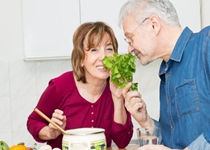 There are some complaints that I seem to hear from friends and family on a regular basis, but one of the most common has to be swelling and pain in the joints. Well, oftentimes, this pain and inflammation may be caused by gout. Luckily, I know my natural health foods and I can offer them—and you—three foods to naturally relieve pain from arthritis.
There are some complaints that I seem to hear from friends and family on a regular basis, but one of the most common has to be swelling and pain in the joints. Well, oftentimes, this pain and inflammation may be caused by gout. Luckily, I know my natural health foods and I can offer them—and you—three foods to naturally relieve pain from arthritis.
Joint pain and swelling are often signs of arthritis. Doctors have diagnosed approximately one in every five adults in the U.S., or 50 million people, with an arthritic condition. You could have one of more than 100 types of arthritis. Osteoarthritis and rheumatoid arthritis are the most well known.
Gout is also a common form of arthritis, and it is known to affect about 6.1 million Americans. The main cause of the condition is an increase of uric acid concentration in fluids within the body. Through the condition, substantial damage and inflammation is caused when uric acid crystals are deposited in the kidneys, tendons, joints, and other tissues. In 50% of cases, it is common for gout to affect the base of your big toe, which is called podagra. Gout can also occur in the hands, knees, ankles, and feet.
Gout is the top inflammatory arthritis known to affect men; however, women are at greater risk after menopause.
Foods to Avoid If You Suffer from Gout
Foods rich in purines are known to dramatically increase the risk of gout attacks. High-purine foods include yeast, organ meats (liver, kidney, brain), sardines, anchovies, and herring. Moderate-purine foods include meat, fish, poultry, shellfish, mushrooms, dried legumes, spinach, and asparagus. (I know—they are some of my favorites too.) It is also best to avoid alcohol. (Click here to see Foods to Avoid with Gout)
What to Eat to Ease Gout Pain
Low-purine foods are highly recommended. They include fruits, nuts, and eggs. There are also other foods that improve the condition of gout. I highly recommend the following three foods, which just may be gout’s toughest natural health opponents:
1. Cherries
Could a common dessert topping also help lower gout attacks? Various studies link cherry consumption and the reduced occurrence of gouty arthritis. In a study published in Arthritis Rheumatism, Boston University researchers had 633 people with the inflammatory condition take cherries and cherry extract for a two-day period. Prior to the study, participants provided information about their gout attacks, including the onset date of the condition, symptoms, anti-gout medications, and other potential risk factors. The researchers found that cherries lowered the risk of gout attacks by 35%.
2. Parsley
There are flavonol constituents in parsley that can lower uric acid levels, including kaempferol and quercetin. Hyperuricemia is a condition with extremely high levels of uric acid. People with the condition are considered to be at greater risk for gout, and it also may lead to cardiovascular diseases and cancer. In a two-week study, researchers found that the quercetin and kaempferol in parsley reduced uric acid levels in rats with hyperuricemia. Parsley is a great addition to salads, smoothies, and juices.
3. Ashwagandha
Ashwagandha is an herb used in ayurvedic medicine. It is a common adaptogenic herb used to relieve stress. Studies also show it is useful for the treatment of gout. In a study published in Chemico-Biological Interactions, ashwagandha root powder slowed the strength and spread of inflammation in rats with gouty arthritis. The herb also worked as a potent painkiller with an anti-fever effect.
There is also evidence to support other foods and herbs for the treatment or prevention of gout. That list includes:
- Cinnamon
- Turmeric and Boswellia
- Curcumin
- Noni fruit juice
Overall, you can improve your gouty arthritic symptoms by upping your intake of vegetables, fruits, and whole grains.
Sources for Today’s Article:
Rasool, M., et al., “Suppressive effect of Withania somnifera root powder on experimental gouty arthritis: An in vivo and in vitro study,” Chemico-Biological Interactions December 15, 2006; 164(3): 174–180.
Haidari, F., et al., “Effects of Parsley (Petroselinum crispum) and its Flavonol Constituents, Kaempferol and Quercetin, on Serum Uric Acid Levels, Biomarkers of Oxidative Stress and Liver Xanthine Oxidoreductase Activity in Oxonate-Induced Hyperuricemic Rats,” Iranian Journal of Pharmaceutical Research Autumn 2011; 10(4): 811–819.
Zhang, Y., et al., “Cherry consumption and decreased risk of recurrent gout attacks,” Arthritis Rheumatism December 2012; 64(12): 2004–2011, doi: 10.1002/art.34677.
Murray, M., et al., The Encyclopedia of Natural Medicine (New York: Atria Paperback, 2012), 622–619.
“What is gout? What causes gout?” Medical News Today web site; http://www.medicalnewstoday.com/articles/144827.php, last updated October 3, 2014.
“Gout,” Arthritis Foundation web site; http://www.arthritis.org/arthritis-facts/disease-center/gout.php, last accessed November 13, 2014.
